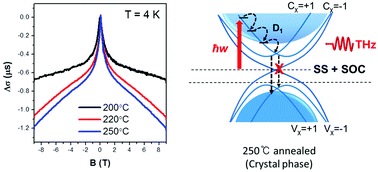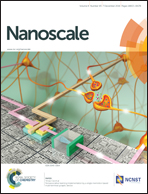Enhancement of carrier lifetime by spin–orbit coupling in a topological insulator of an Sb2Te3 thin film†
Abstract
Electrons and phonons in chalcogenide-based materials are important factors in the performance of optical data-storage media and thermoelectric devices. However, the fundamental kinetics of carriers in chalcogenide materials remains controversial, and active debate continues over the mechanism responsible for carrier relaxation. In this study, we used optical-pump terahertz-probe spectroscopy, which permits the relationship between structural phase transition and optical property transitions to be examined, to investigate the ultrafast carrier dynamics in a multilayered [Sb(3 Å)/Te(9 Å)]n thin film during the transition from the disordered to crystalline phase. Using terahertz time-domain spectroscopy and a contact-free optical technique, we demonstrated that the optical conductance and carrier concentration vary as functions of annealing temperature. Moreover, we observed that the topological surface state (TSS) affects the enhancement of the carrier lifetime, which is closely related to the degree of spin–orbit coupling (SOC). The combination of the optical technique and proposed carrier relaxation mechanism provides a powerful tool for monitoring TSS and SOC. Consequently, it was determined that the response of the disordered phase is dominated by an electron–phonon coupling effect, while that of the crystalline structure is controlled by a Dirac surface state and SOC effects. These results are important for understanding the fundamental physics of phase change materials and for optimizing and designing materials with better performance in optoelectronic devices.


 Please wait while we load your content...
Please wait while we load your content...